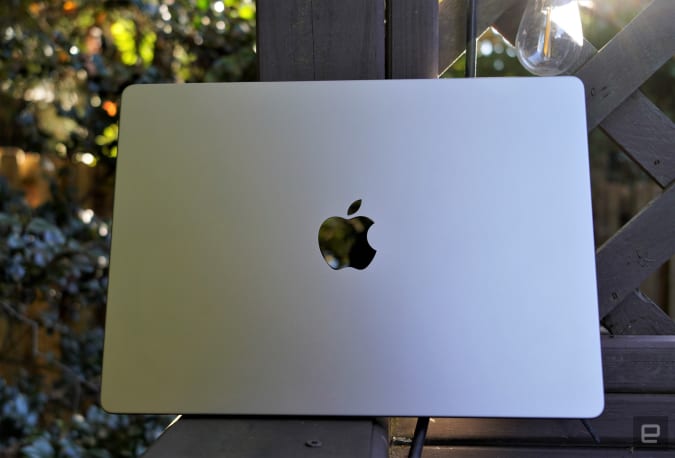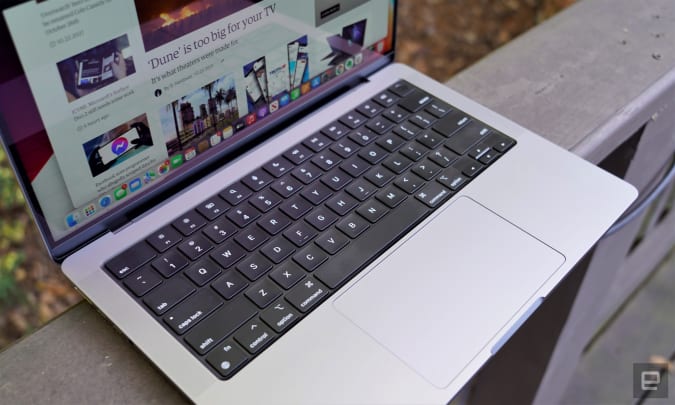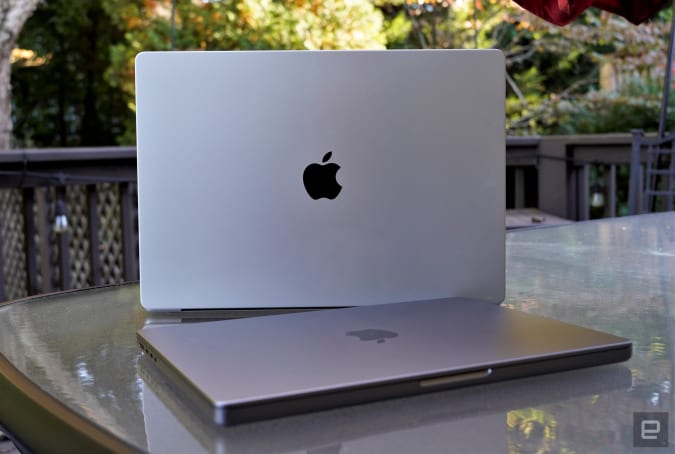Image Credit: Devindra Hardawar/Engadget
Our 14-inch review model was equipped with an M1 Pro sporting 16 GPU cores, 32GB of RAM and a 1TB SSD. The 16-inch had the 32 GPU core M1 Max, a 2TB SSD and a whopping 64GB of RAM. (This, by the way, marks the first time I've reviewed a laptop with that much RAM.) Both of Apple's new chips also feature 10 CPU cores — for comparison, the M1 had eight CPU cores and eight GPU cores.
Geekbench 5 CPU | Cinebench R23 | Disk speed (top reads/writes) | |
Apple MacBook Pro (14-inch) | 1,767/11,777 | 1,515/12,118 | 5.1 GB/s / 5.8 GB/s |
Apple MacBook Pro (16-inch, 2021) | 1,783/12,693 | 1,524/12,281 | 5.1 GB/s / 6.2 GB/s |
Apple MacBook Pro (Apple M1, 13-inch, 2020) | 1,696/7,174 | 1,492/7,467 | 3GB/s / 3GB/s |
Dell XPS 15 (Intel i7-11800H, RTX 3050 Ti) | 1,536/7,551 | 1,506/9,453 | 2.8 GB/s / 2.6 GB/s |
Razer Blade 14 (AMD Ryzen 9 5900HX. RTX 3080) | 1,443/7,226 | 1,461/11,502 | 3 GB/s / 2 GB/s |
Just based on specs, I expected to see some wild performance improvements. And the benchmarks didn't disappoint: According to GeekBench 5, both MacBook Pros blew away every Windows PC we reviewed this year by a significant margin. That includes the NUC 11 Extreme powered by Intel's Core i9-11900KB, a high-end desktop CPU! The single-core performance on the M1 Pro and Max was similar to the M1, which is unsurprising. But the multi-core figures were far higher. Another nice plus: Both of these computers are equipped with very fast NVMe SSDs, which will be a huge help when working with large projects.
The GPU-heavy Geekbench 5 Compute score made it clear that Apple hasn't completely surpassed the likes of NVIDIA and AMD, though. The 14-inch MacBook Pro was more than twice as fast as the Surface Pro 8 (running Intel's Xe graphics) and the M1-equipped 13-inch MacBook Pro, while the bigger notebook was on-par with the Surface Laptop Studio equipped with an NVIDIA 3050 Ti. These aren't bad scores, but it makes it clear that users who need serious power for 3D rendering or data crunching may be better off with PCs equipped with dedicated GPUs.

Devindra Hardawar/Engadget
I don't think those are the people Apple is trying to court, though. Instead, the 14 and 16-inch MacBook Pros seem like an attempt to get back in the good graces of audio and video producers. Apple's new chips will certainly be more than enough for dealing with media. Both computers managed to convert a 4K video clip to 1080p in 34 seconds with Apple's VideoToolbox hardware encoder, which is four seconds slower than the NUC 11 Extreme, but four seconds faster than the XPS 15. They were also among the fastest Cinebench R23 performers we saw this year — only the ASUS ROG Strix G15 gaming laptop bested them.
And before you ask, no, the M1 Pro and M1 Max don't magically turn these computers into gaming rigs. Sure, everything on Apple Arcade runs smoothly, but that was true of the MacBook Air. When I tried to load Borderlands 3, one of the few semi-recent games that actually works on Macs, I just got an unplayable mess running below 30fps. Maybe the the guarantee of decent GPUs will encourage more game developers to build for Macs, but more likely they'll just end up making sure their iPhone and iPad games run smoothly.
Surprisingly, I didn’t notice a huge difference in performance when I was running the MacBook Pros on battery. PCs often slow down dramatically whenever they’re disconnected from a socket, but not so with these notebooks. That’s useful if you need to encode something remotely and you’re willing to sacrifice battery life to get it done.
Don’t worry though, the efficiency of the M1 chip’s ARM design leads to great battery performance. The 14-inch MacBook Pro lasted 12 hours and 35 minutes in our benchmark, while the 16-inch went for 16 hours and 34 minutes. That’s over five hours longer than the last Intel model.

Devindra Hardawar/Engadget
It’s clear that Apple listened to many of the complaints from Mac fans (and perhaps even lowly reviewers). But really, that’s something the company has been doing more over the years, like when it finally moved away from those awful butterfly keyboards to more tactile Magic Keyboards. By the way, typing on the 14 and 16-inch MacBook Pro remains excellent, and the trackpad is a dream to use, as always. And I didn't miss the TouchBar at all—having a few short keys up top just felt more useful.
Apple didn't skimp on the audio front either. Both MacBook Pros sport a six-speaker array, made up of two tweeters and four force-cancelling woofers. Simply put, they sound miraculous. I normally just play a few songs on notebook speakers to confirm how disappointing they are. But these laptops sounded like I was listening to two small bookshelf speakers, with transparent vocals and punchy bass. Yes, I'm as shocked as you are.
The 16-inch MacBook Pro sounds a bit better, since it has room for slightly bigger drivers, but both notebooks are enough for a private jam session. The MacBook Pro's microphones also do a solid job of capturing speech during video calls. I wouldn't use them to record professional music, as Apple suggested you could, but they’re probably fine for a quick podcast session on the road.
Wrap-up

Devindra Hardawar/Engadget
So if you’re in the market for one of these new computers, which should you get? If you’re mostly using it for general productivity tasks, then I’d lean towards the 14-inch model, which was just easier to travel with. It’s a good option for coders and people who may not need a ton of screen real estate. But all of the video and audio producers I’ve talked to were unequivocal: they wanted to go big with the 16-inch model.
The biggest downside of the new MacBook Pros are their high prices — but really, what else do you expect from Apple? The 14-inch model, in particular, will probably give you the vapors if you're comparing it to the 13-inch MacBook Pro. But in the world of gaming and high-end productivity notebooks, Apple's pricing isn't that far off. The Razer Blade 14, for example, is just two hundred dollars less than the MacBook Pro 14-inch. Dell's XPS 15 OLED is around $500 cheaper than the cheapest 16-inch MBP, but that's with a CPU that's much slower than Apple's. Once you start speccing that machine up, though, you’ll likely pay close to $2,500.
On the whole, these computers have practically everything we’d want in a powerful notebook. If you're a creative professional with a large budget for a new computer, and you want something that'll genuinely speed up your workflow, the new MacBook Pros are exactly what you need.
All products recommended by Engadget are selected by our editorial team, independent of our parent company. Some of our stories include affiliate links. If you buy something through one of these links, we may earn an affiliate commission.
https://news.google.com/__i/rss/rd/articles/CBMiXWh0dHBzOi8vd3d3LmVuZ2FkZ2V0LmNvbS9tYWMtYm9vay1wcm8tMTQtMTYtaW5jaC1yZXZpZXctMjAyMS1hcHBsZS1taWdodHktbWFjcy0xMzAwMTE5NzUuaHRtbNIBYWh0dHBzOi8vd3d3LmVuZ2FkZ2V0LmNvbS9hbXAvbWFjLWJvb2stcHJvLTE0LTE2LWluY2gtcmV2aWV3LTIwMjEtYXBwbGUtbWlnaHR5LW1hY3MtMTMwMDExOTc1Lmh0bWw?oc=5
2021-10-25 13:00:39Z
Tidak ada komentar:
Posting Komentar